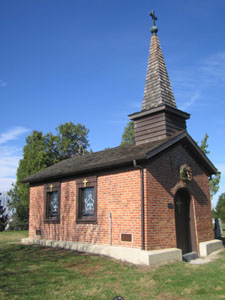By Margie Wuebker
mwuebker@dailystandard.com MINSTER -- A weathered brick chapel standing amid the tombstones of St. Augustine Cemetery has a new lease on life, thanks to an ambitious restoration project spearheaded by the Minster Historical Society.

The restoration project originated from a cemetery board discussion three years ago focusing on the chapel's deteriorating condition. Historical Society members Richard Stein, Kurt Lammers and Al Freytag were present at the session.
One proposal called for the landmark to be moved to the south end of the cemetery and a portico and carillon added.
The offer by the Historical Society to restore the 12 by 18-foot building where it has stood for 150 years quickly gained acceptance. The men left jubilant, but not aware they were embarking on a three-year odyssey -- one that apparently lasted longer than the original construction.
"I guess we are just preservationists at heart," Stein, the Historical Society president, admits with a smile. "So much history resides in a cemetery like this and we were not about to let the chapel go." The original brick building was constructed on the northwest corner of the cemetery and represents one man's promise made to God in the mid-1800's.
John Henry Steinemann, an Auglaize County pioneer who came to the area in 1836, purchased a number of cemetery plots and built the chapel.
"His wife (Catherine Gertrude Meyer) came down with a serious illness and he vowed to build a chapel if she recovered," Stein says. "She survived and he set to work."
The chapel, constructed of red brick made at Steinemann's brickyard, took shape in 1855 amid stately pine trees and weathered limestone grave markers.
"This is kind of a hallowed area," Stein says. "Romance as well as great tragedy is reflected here."
Not far from the chapel is a carved monument denoting the final resting place of more than 300 area residents who fell victim to cholera in 1848. Over yonder are graves of Irish immigrants who came to dig the Miami-Erie Canal.
If brick walls could talk, the chapel would share tales of military veterans ranging from Civil War through Vietnam War being laid to rest. There would be stories about each person added to the census -- the baker, the woodcarver, the grocer, the town doctor, the barber and the undertaker among others -- over the years. Some lived many years before taking the last ride; others far too few.
"We know small funerals and Masses took place in the chapel," Stein says. "But we have no records of weddings."
The structure gradually fell victim to the effects of nature despite occasional restoration projects. The elements, not to mention lady bugs, flies and other insects, defied attempts to shore up old windows with large sheets of plywood.
A legion of dedicated volunteers envisioned a goal far removed from dust and dampness. The old wood floor fell victim to pry bars revealing sand and flat stones that were replaced with poured cement stamped to resemble flagstone. Rebar in the floor affords greater stability. The installation of wiring, vents, wallboard and heating components paved the way for painting.
The porous bricks, originally held in place with mud, received a generous coat of sealant while new copper spouting and cement footers were installed in hopes of alleviating moisture problems.
The Historical Society obtained four stained glass windows salvaged from St. Patrick's Catholic Church in neighboring Shelby County. The windows, which had to be reglazed and sealed, are finished with cross-tipped lintels on the outside and rich dark molding inside matching that installed near the floor.
Local resident Leon Mertz fashioned a sturdy altar using a massive beam from the former Wooden Shoe Brewery. The choice adds another family touch to the surroundings, as John Henry Steinemann's sons were officers of the company during its heyday.
A painting, which depicts souls in Purgatory reaching up to God, again hangs behind the altar. It originally came from Oldenburg, Germany, two years before Steinemann built the chapel. The unsigned artwork had been removed in recent years to prevent damage from the elements.
Stein said the chapel will remain a work in progress despite the fact that rededication ceremonies were held earlier this month.
Future plans call for the installation of one or two short pews for worshippers instead of the lone kneeler now in place. Stein also envisions a series of stations depicting the way of the cross and a commemorative plaque to recognize benefactors.
Clear plastic cases will protect the old painting as well as a century-old Sacred Heart of Mary picture provided by local pastor Rev. Louis Schmit. The added protection will be needed as the Historical Society plans to have the chapel open from dusk to dawn nine months out of the year. The structure will be "buckled up" for winter January through March.
Although long and involved, the restoration project has been a source of satisfaction for Historical Society members and volunteers who continue to marvel at the transformation.
"This chapel represents a promise made and a promise kept," Stein says. "By an early resident and by a group of dedicated individuals who also call Minster home." |

